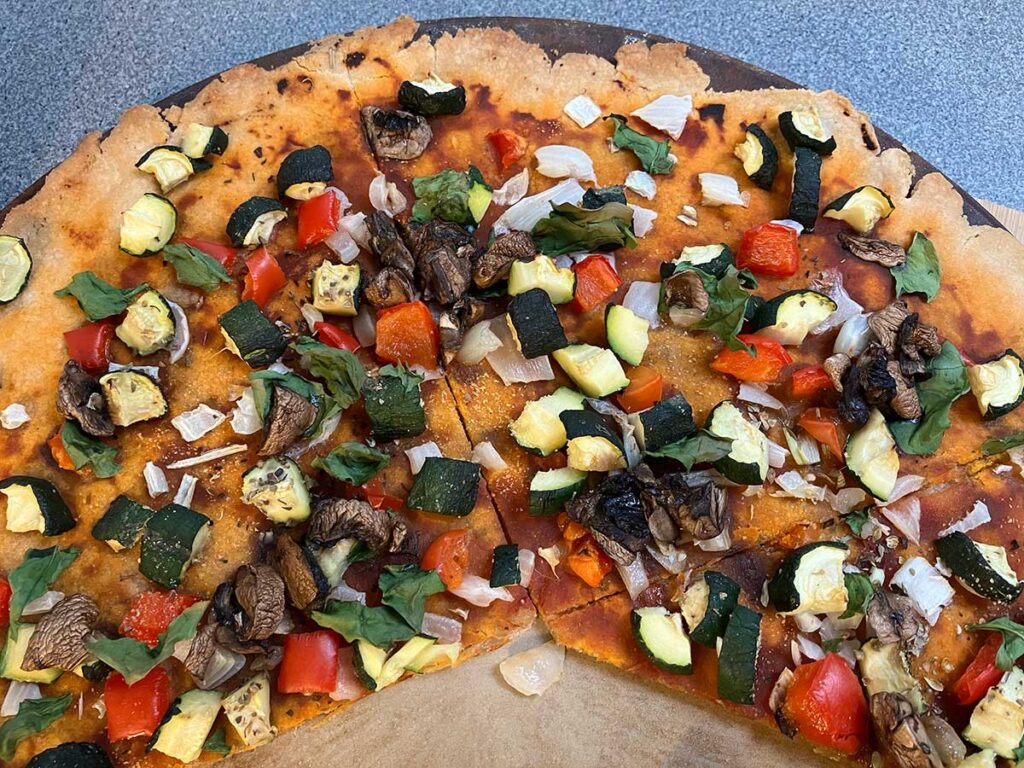Last Updated on October 10, 2024 by Cathy

Diet plays a big role in managing multiple sclerosis (MS) symptoms. Eating the right foods reduces inflammation, boosts energy, and supports health. By filling your plate with nutrient-dense foods, you’re giving your body what it needs to feel its best. But with so many different diets for MS out there, it’s hard to know what to eat.
Diets like The Wahls Protocol and AIP recommend plenty of veggies and healthy fats. They focus on nutrient-rich foods. Other diets, like the Swank and Overcoming MS (OMS) diet, focus on limiting meat and fats. It can get confusing to figure out what’s best for you.
I’m not cutting any MS diet down, they all work—I know because I’ve tried many of them. However, from my experience, not one diet reversed any of my symptoms. It wasn’t until I combined diets that my symptoms began to reverse.
Sometimes you have to look outside the box because not one diet is perfect for everyone. Meaning, look at other healthy diets. People in Blue Zones, are people who live the longest and healthiest lives. They are areas around the world and they eat different diets.
The China Study is a nutrition research project in rural China where they fewer diseases. The Nurses’ Health Study followed female nurses in the U.S. for many years. They also had lower rates of diseases.
What do all these diets have in common? They eat more plant-based foods—vegetables!

Why Your Plate Should Be Mostly Vegetables

The Western diet is full of processed foods, sugar, unhealthy fats, and red meat. These can cause inflammation and lead to chronic diseases—MS is a chronic disease. It also lacks important nutrients and fiber found in whole, plant-based foods. This makes it harder for the body to stay healthy.
Filling your plate with vegetables is important for healing from MS. Vegetables are packed with vitamins, minerals, and antioxidants. These nutrients help your body stay strong and fight off illness. They also provide fiber, which is good for digestion and constipation—a common MS symptom. Plus, they help keep you full.
Eating plenty of vegetables can help reduce inflammation. Inflammation is a major factor in MS, and many vegetables have properties that lower it. For example, leafy greens like spinach and kale are great choices. They are rich in antioxidants, which protect your cells.
Variety is key when it comes to vegetables. Different types of veggies offer different nutrients. Leafy greens provide vitamins A, C, and K. Cruciferous vegetables like broccoli and cauliflower have compounds that may help fight cancer. Root vegetables like sweet potatoes are full of fiber and beta-carotene. Eating a mix of these foods ensures you get a wide range of nutrients.
To make your meals colorful and exciting, try to include a variety of vegetables. Aim for different colors and types in every meal. This way, you will benefit from all the nutrients they offer while supporting your body. The perfect plate of food balances nutrients to support your health while managing MS symptoms. Remember, the more veggies you eat, the healthier you will feel!
The Wahls Protocol – Focusing on 9+ Cups of Veggies a Day

The Wahls Protocol is an approach created by Dr. Terry Wahls. She developed this diet to help manage her own MS symptoms. The diet focuses on eating lots of vegetables. Dr. Wahls believes the right foods can help improve health and reduce inflammation. This approach works for many people because it emphasizes nutrient-dense foods.
The Wahls diet recommends eating at least 9 cups of vegetables each day. This may sound like a lot, but it can be manageable when you divide them into groups.
Dr. Wahls recommends eating 3 cups of each every day:
- Leafy greens, like spinach or kale. These greens are packed with nutrients.
- Sulfur-rich vegetables, such as broccoli, cauliflower, or cabbage. These veggies help support your body’s detox process.
- Colorful vegetables, like carrots, beets, and red cabbage. These colorful options provide different vitamins and antioxidants.
To fill your plate based on the Wahls Protocol:
- Start with a large salad made of leafy greens.
- Add steamed broccoli and cauliflower for the sulfur-rich veggies.
- Then, include roasted carrots or red cabbage for the colorful vegetables.
This plate will be not only delicious but also full of the nutrients your body needs. Following The Wahls Protocol can help you feel better and support your health!
The AIP Diet – Managing Food Sensitivities

The Autoimmune Protocol (AIP) is a special diet. It aims to help people with autoimmune diseases. The diet removes foods that might cause inflammation like nightshades. It adds foods that may heal the gut. People follow AIP to reduce symptoms and improve health. The diet is strict at first, then slowly adds foods back.
When it comes to vegetables, there are many AIP-friendly options. You can enjoy leafy greens, as well as cruciferous vegetables like broccoli. Other good choices include carrots, zucchini, and sweet potatoes. These veggies are not only allowed but are also packed with nutrients to support your health.
To avoid overloading on any one type of vegetable, try rotating your choices. For example, if you eat spinach one day, switch to kale the next. You can also alternate between broccoli and cauliflower. This ensures you get enough nutrients and lowers the risk of new sensitivities.
To build an AIP plate:
- Start with a large serving of leafy greens for your base.
- Add roasted sweet potatoes and steamed broccoli for different flavors and nutrients.
- Finish with a side of sautéed zucchini or carrots.
This plate will be full of AIP-compliant veggies. It also helps you manage food sensitivities while supporting your health.
Eating Less Meat and Fat – Swank and OSM Approaches

Low-meat diets can help manage MS symptoms. Dr. Roy Swank created a low-fat approach that limits animal fats. The OSM diet also focuses on eating less saturated fat. Both diets emphasize eating a plant-based diet. Studies show that people who eat more plants often live longer and healthier lives.
When choosing meat, it’s important to choose healthy lean protein sources. Small portions of fish or chicken can be good options. You can also enjoy plant-based proteins. Mushrooms and algae are great choices that fit the AIP diet and provide protein without meat.
Healthy animal proteins include:
- Wild-caught fish
- Pasture-raised poultry
- Grass-fed and finished meats
- Game meats
Healthy fats are also important but should be eaten in moderation. Good fats include olive oil, avocados, and coconut. These fats provide energy and support brain health. It’s best to keep portions small, especially with Swank-style eating.
To create a low-meat, low-fat plate:
- Start with a big serving of mixed greens.
- Add colorful veggies like carrots, red bell peppers, and zucchini.
- For protein, include a small piece of grilled chicken or a serving of sautéed mushrooms.
- Drizzle a little olive oil on top for healthy fat.
This plate will be filled with nutrients and flavors while keeping meat and fat in check. Following these guidelines can help you feel better and support your health!
How to Combine All of These Approaches into Your Daily Plate

Combining different dietary approaches can help you create a balanced plate. A good rule is to fill 75% of your plate with vegetables. This means lots of colorful veggies! Aim for 10-15% of your plate to be protein and 10-15% for healthy fats. This simple structure will help you get the nutrients you need.
To keep your perfect plate of food from getting boring, focus on a variety of different foods. This will also give you the most nutrients so your body can heal.
Here’s an example of a full day of eating:
- Breakfast: Start with a smoothie of spinach, banana, wild blueberries, and filtered water. Add ground flaxseeds for fiber, omega-3, and protein.
- Lunch: Have a big salad with mixed greens, shredded carrots, cucumbers, and green onions. Drizzle lemon juice mixed with a little raw honey on top for dressing.
- Snack: Enjoy sliced bell peppers, cucumber, or roasted vegetables with tahini sauce.
- Dinner: Roast sweet potatoes, broccoli, and cauliflower. Serve with a small piece of baked fish and avocado on the side.

This way, you can enjoy a variety of delicious meals while supporting your health! For a delicious and satisfying meal, aim for the perfect plate of food with a mix of greens, proteins, and healthy fats. Everyone’s idea of the perfect plate of food may vary, so experiment to find what works for you.
Note: both the Swank diet and OMS diet allow legumes. The Wahls Protocol and AIP diet recommend avoiding legumes. If you follow the Medical Medium diet, he also recommends avoiding legumes for people with MS. All three believe legumes can block nutrient absorption and trigger an immune response. After you’ve healed you can add them back into your diet.
Troubleshooting Common Issues (What If I Don’t Like Vegetables?)

If you find it hard to like vegetables, don’t worry! There are many ways to make them tasty. Try different cooking methods to discover what you enjoy. For example, I used to not like Brussels sprouts. Then I started roasting them with a marinade of pure maple syrup and seasonings—yum!
Roasting veggies can bring out their natural sweetness. Toss root vegetables with a little olive oil, salt, and pepper, then roast them in the oven until they are golden. You can also blend vegetables into soups. Creamy soups made with cauliflower or butternut squash can be delicious and comforting.
Reducing meat doesn’t have to feel hard. Start by replacing one meat meal with a plant-based option each week. For example, if you have chicken for dinner, try a hearty vegetable stir-fry instead. You can also enjoy small portions of lean proteins, like fish, while adding more veggies. This way, you still get protein but focus more on plants.
Mushrooms are a perfect meat replacer. Instead of using meat in stews or tacos (using gluten-free wraps) swap the meat out for mushrooms.
If you have food sensitivities, identify which vegetables may cause reactions. Start by trying an elimination diet. Write down what you eat and how you feel afterward. This can help you spot patterns. If a certain veggie bothers you, try replacing it with another. If tomatoes upset your stomach, try cucumbers or carrots in your salads.
Staying Consistent – Tips for Sticking with This Lifestyle

This is a homemade ketchup I made, you can find the recipe in my cookbook: Eating Healthy With MS.
Meal prepping is a great way to stay on track. Set aside a few hours each week to prepare your meals. Wash and chop vegetables and portion out snacks. Having meals ready to go can save you time and help you make better choices when you’re busy.
Here’s a simple time-saving trick: when chopping veggies, like an onion, chop the whole thing. Use what you need and store the rest for later. This saves both time and energy!
Another trick is to always keep healthy food readily available. If you’re hungry and don’t have a quick healthy snack it will be too tempting to grab something you’ll regret later.
When shopping, make a list of the foods you need. Stick to the list to avoid buying items that don’t fit your meal plan. Choose fresh vegetables and fruit, and healthy proteins. Frozen fruits and vegetables are also good options. If you can, shop at local farmers’ markets. They often have fresh, seasonal produce that can inspire new meal ideas.
It’s important to listen to your body as you follow this lifestyle. Everyone’s needs are different. Some days you may feel like eating more protein, while other days you might crave more fruits or veggies. Be flexible and adjust your meals based on how you feel. If you try a new vegetable and don’t like it, that’s okay! There are plenty of other options.
Remember, it’s about finding what works for you. Celebrate small victories and don’t be hard on yourself if you stray from your plan. Gradual changes will help you build a lasting, healthy lifestyle. You can do this!
Building the Perfect Plate of Food

This is a pizza I made, you can find the recipe in my cookbook: Eating Healthy With MS.
Balancing different ways of eating is possible, and it can help manage MS symptoms. Remember, you don’t have to be perfect. If you make a mistake, don’t beat yourself up, and keep eating healthy. Making small changes can lead to big improvements in how you feel. Filling your plate with more vegetables and reducing your meat intake is a great place to start.
Don’t be afraid to experiment! Try new recipes and different cooking methods. See which veggies you enjoy and how they make you feel. You might discover that you like roasted vegetables or creamy soups.
Listen to your body and find what works best for you. Each person’s needs are unique, and that’s okay. Remember, the perfect plate of food doesn’t have to be complicated; simple ingredients work great together.
I encourage you to take action! Start by planning your next meal with plenty of vegetables and a smaller portion of meat. This simple step can make a big difference.
With patience and practice, you can create a balanced plate for better health. Remember, every small change counts. You have the power to take charge of your eating habits and feel better. Enjoy the journey to a healthier you!

Want to remember this health tip? Pin it to your Pinterest board!

Building the Perfect Plate of Food to Manage MS





